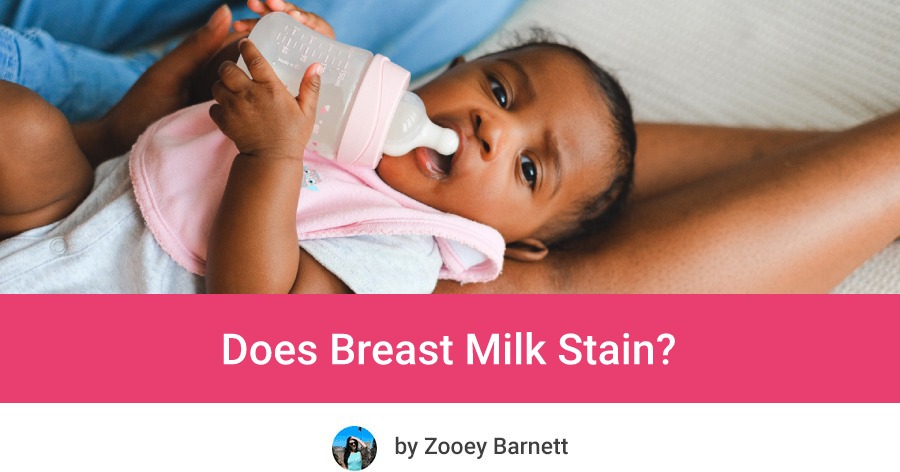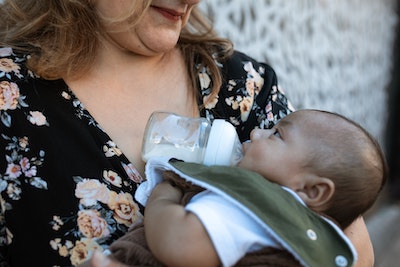
This article is not a substitute for medical advice.
Welcome to the world of motherhood! As a mom, you will come across a lot of challenges, from sleepless nights to breast milk stains. Breast milk is a magical liquid, but it can be a pain when it comes to laundry.
Have you ever tried to remove breast milk stains from your clothes? It can be quite a daunting task.
In this article, we’ll discuss why breast milk stains, why it’s so difficult to remove these stains, and some tips on how to get rid of them quickly and easily (including baby-safe options for those cute onesies). So, grab your favorite cup of coffee and let’s dive in!
Does Breast Milk Stain?
Yes, breast milk can stain clothes and other materials. There are actually two types of breast milk stains:
- Protein stains – which need to be treated right away and kept away from the heat (like hot water or sun), otherwise it will be really hard to get rid of those icky yellow stains. They also require enzymes to break down1.
- Greasy stains – these ones come from the fat that is in the breast milk.
Why It’s So Hard To Remove Breast Milk Stains?
Breast milk stains can be tricky to remove and may require a few extra steps to ensure successful removal. To prevent staining, you should always check care labels before washing and use a gentle detergent.
Breast milk is composed of fats, proteins, and sugars, and these ingredients can be quite stubborn when it comes to fabric.
The proteins in the milk are especially prone to staining, as they can bind to the fabric and become difficult to remove.
Heat and friction can cause these proteins to bond even further, making them even harder to get rid of.
Sunlight can also cause the proteins to oxidize and turn yellow, making them even more pesky and difficult to remove.
But don’t worry, with a few simple steps and the right products, you can easily get rid of those stubborn breast milk stains.
Breastmilk stains are not the only hard-to-remove stains you will have to deal with as a mom. Poop stains are also really stubborn and require special “treatment”!

How To Get Breastmilk Stains Out Of Clothing
Be prepared that breast milk stains WILL HAPPEN. Those adorable onesies will get stained and your nursing bras and tank tops will have a yellow tint (because you know, when you’re breastfeeding on one breast, the other breast leaks too – that’s why I recommend wearing nursing pads or using milk collector).
So how to get breast milk stains out of your favorite clothes (or your baby’s clothes)?
Simple Steps For Removing Fresh Breast Milk Stains From Your Clothes
When your nursing pad leaks, your baby spits up or the milk is coming out of their nose and staining those cute onesies, it’s important to act fact to fight those breastmilk stains. Here are some simple steps for removing new breast milk stains from your clothes:
- Blot the stain with a clean cloth or paper towel to remove as much of the breast milk as possible.
- Rinse the breastmilk off ASAP to prevent the stain from setting.
- Spray with a stain remover. If you’re removing stains from baby clothes I recommend you to either use natural home-made or baby-safe stain remover.
- Scrub it gently with a sponge or toothbrush.
- Soak the stained area in cold water for about 10-30 minutes.
- Use a gentle detergent to launder the garment. For baby clothes use baby-friendly detergent. Because the breastmilk contain proteins they require enzymes to breast down the stain so make sure to choose a detergent with enzymes.
- Let your clothes to air dry in the sun. The good news is that sun is also a natural bleacher! If you have black or colorful clothes, don’t leave them in direct sunlight. If you prefer to tumble dry, make sure to choose low setting and check the clothes first if there are no remains of breastmilk stains.
By the way, detergents with enzymes are not suitable for wool and silk, so you will need to use something else if these fabrics get stained with your precious breastmilk.
Removing Set-In Breast Milk Stains
You may not also have the time or opportunity to deal with the breast milk stains right away.
If you’re out and about and your little one spits up or your bottle happens to leak it’s best to put the stained clothes in a wet bag (here are the best ones that I recommend), so the breast milk doesn’t get all over your diaper bag.
And once you’re back home, here’s what you should do to get rid of these pesky breast milk stains:
- Wash the area with water to get rid of any residue.
- Spray your chosen stain remover onto the fabric and use a soft-bristled brush to rub the pretreatment GENTLY into the stain. Give the product time to work, at least 15 minutes but up to 24 hours (check the instructions on your stain remover).
- Follow the instructions on your clothing label when washing.
- Let the fabric dry in the sun.
If the stain is persistent, you may need to repeat this again: rinse and wash again. It may take some effort, but even with stubborn breastmilk stain, you can get your favorite tank top looking bright and clean as new.
Which Cleaning Products Are Safe To Use To Get Rid Of Breastmilk Stain From Baby’s Clothes?
When it comes to cleaning up those pesky breastmilk stains on baby’s clothes, you want to make sure you’re using the gentlest, safest products possible. Natural options, such as baking soda or white vinegar, are the best choice for delicate skin.
You can also use a mild detergent, or an enzyme-based cleaner specifically designed to tackle stubborn stains (like milk stains).
Pre-treat the stain with a small amount of cleaner, then wash it according to the instructions.
Make sure to check the ingredients of laundry detergent you’re using for baby’s clothes – it should be free of any allergens and irritants. Avoid fabric softeners, dyes, and perfumes.
By the way, it’s best to let baby clothing air dry to avoid shrinking. Moreover, I don’t recommend using dryer sheets for baby clothes, because they are full of harsh chemicals that can irritate baby’s delicate skin.

Natural Products To Get Rid Of Stains From Breast Milk – DIY Tips
There are several natural products that you can use to help fight stains from breast milk.
-
White Vinegar
White vinegar is a great option as it is a natural disinfectant, deodorizer and stain remover. You can mix equal parts white vinegar and water and use it to pre-treat the stained area.
-
Baking Soda
Another useful natural substance is baking soda. It can be used to make a paste with water and applied directly to the stain.
-
Lemon Juice
You can also use lemon juice to help lift the stain; simply apply some lemon juice to the area and let it sit for a few minutes before washing.
-
Hydrogen Peroxide
For tougher stains, you can also use hydrogen peroxide; just make sure to test it on a small, hidden area of the fabric first to ensure it won’t discolor the fabric.
Can I Use Bleach?
It is not recommended to use bleach to remove breast milk stains from clothes as it can be damaging to the fabric and can cause fading. It is also not safe for baby’s clothing2.
Instead, you could try soaking the stained clothes in cold water for about 30 minutes before laundering with a gentle detergent. You could also try treating the stain with a spot remover or a paste made of baking soda and water.
Be sure to check for colorfastness of the fabric before attempting to remove the stain.
Best Ways To Get Breast Milk Stains Out Of Carpets & Upholstery?
The best way to get breast milk stains out of carpets and upholstery is to act quickly when the stain is fresh.
- First, blot the stain with a clean, absorbent cloth or paper towel. Work from the outside of the stain inwards to avoid spreading the stain further.
- Next, mix a solution of cold water and dishwasher soap. Apply the solution to the stain and continue to blot the area to remove the milk. Don’t use warm water! Only cold water keeps protein and fat stains from setting in.
- To avoid any water marks keep blotting the carpet/upholstery with paper towels.
- Rinse the area with plain water, other the soap solution may leave some marks.
- Depending on the fabric, you may need to use a spot cleaner formulated for use on carpets and upholstery. If so, follow the instructions provided on the product label.
How Can I Avoid Breast Milk Stains?
It can be difficult to avoid breast milk stains, especially when you’re breastfeeding often. However, there are a few tips you can follow to help minimize the chances of staining.
-
Wear Nursing Pads
Nursing pads are an excellent way to avoid breast milk stains as they act as a barrier between your clothing and your skin.
-
Use A Milk Collector
When you’re breastfeeding on one breast, milk is coming out of the other breast too. Nursing pad can soak it up preventing any leakage and stubborn stains on your nursing bra.
But instead of wasting that precious liquid, you can collect it from the other breast using a milk catcher like Haakaa or Elvie Curve.
-
Pre-Treat The Stains
If you do happen to get a stain, rinsing it off and pre-treating it immediately with a stain remover can help keep it from setting in.
-
Wash Your Clothing In Cold Water
Washing your clothing in cold water can help keep the breast milk protein-based stains from setting in.
-
Protect Your Clothes & Nursing Pillow During Feeding Time
Use an old blanket or towel to place it over you and/or nursing pillow to avoid tough stains from breast milk.
By following these tips, you should be able to reduce the chances of getting breast milk stains on your clothing.
Does Baby Formula Stain The Same Way As Breastmilk?
Yes, unfortunately baby formula does stain in the same way as breastmilk, because it also contains protein and fats. It’s important to clean any stains quickly to keep to avoid ruining your clothes completely.
Use the same methods for removing formula stains, as breast milk stains.
The purpose of this article is informative. It’s not a substitute for professional medical advice or medical care. Remember: safety first! Consult your doctor/pediatrician in case of any doubts. The author of this article does not accept any responsibility for any liability, loss or risk, personal or otherwise, incurred as a consequence, directly or indirectly, from any information or advice contained here.
References:
https://www.thespruce.com/protein-based-stains-1901073
https://www.aarp.org/health/conditions-treatments/info-2020/bleach-precautions.html

